You are migrating SAP to Azure. The ASCS application servers are in one Azure zone, and the SAP database server in in a different Azure zone. ASCS/ERS is configured for high availability.
During performance testing, you discover increased response times in Azure, even though the Azure environment has better computer and memory configurations than the on-premises environment.
During the initial analysis, you discover an increased wait time for Enqueue.
What are three possible causes of the increased wait time? Each correct answer presents a complete solution.
NOTE: Each correct selection is worth one point.
CDE
E: The network latency across Availability Zones is not the same in all Azure regions. In some cases, you can deploy and run the SAP application layer across different zones because the network latency from one zone to the active DBMS VM is acceptable. But in some Azure regions, the latency between the active
DBMS VM and the SAP application instance, when deployed in different zones, might not be acceptable for SAP business processes.
References:
https://docs.microsoft.com/en-us/azure/virtual-machines/workloads/sap/sap-ha-availability-zones
You have an on-premises SAP environment that uses AIX servers and IBM DB2 as the database platform.
You plan to migrate SAP to Azure. In Azure, the SAP workloads will use Windows Server and Microsoft SQL Server as the database platform.
What should you use to export from DB2 and import the data to SQL Server?
C
To migrate DB2 databases to SQL Server, you must connect to the DB2 database that you want to migrate. When you connect, SSMA obtains metadata about all
DB2 schemas, and then displays it in the DB2 Metadata Explorer pane.
References:
https://docs.microsoft.com/en-us/sql/ssma/db2/connecting-to-db2-database-db2tosql?view=sql-server-ver15 https://docs.microsoft.com/en-us/biztalk/adapters-and-accelerators/adapter-sap/import-sap-data-using-sql-server-management-studio
HOTSPOT -
You are designing the backup for an SAP database.
You have an Azure Storage account that is configured as shown in the following exhibit.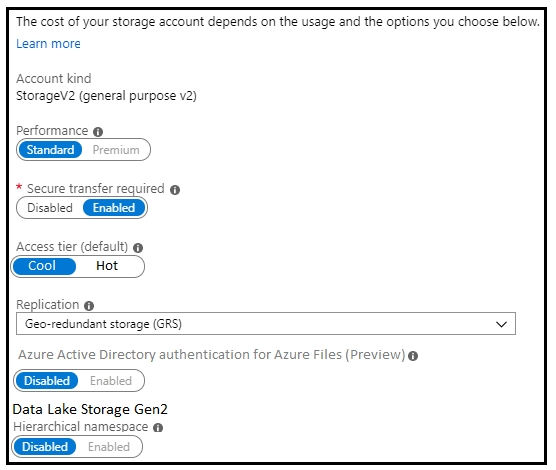
Use the drop-down menus to select the answer choice that completes each statement based on the information presented in the graphic.
NOTE: Each correct selection is worth one point.
Hot Area: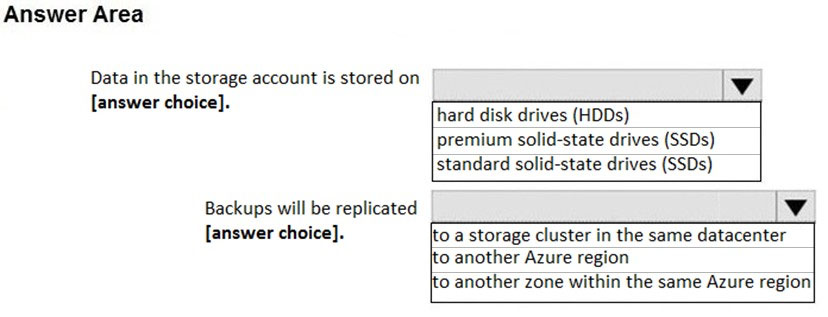
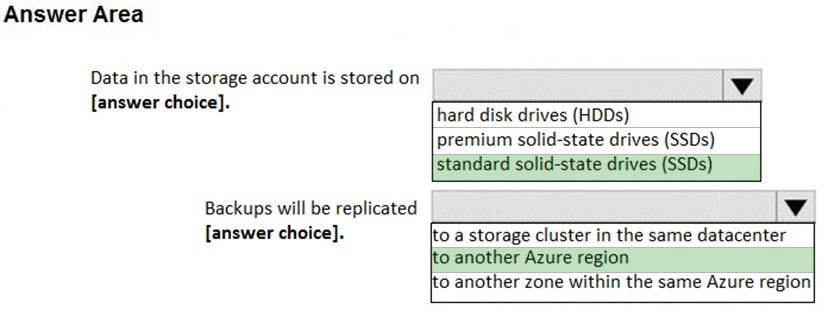
Box 1: standard solid-state drives (SSDs)
Standard SSD Managed Disks, a low-cost SSD offering, are optimized for test and entry-level production workloads requiring consistent latency.
Box 2: to another Azure region -
Geo-redundant storage (GRS) copies your data synchronously three times within a single physical location in the primary region using LRS. It then copies your data asynchronously to a single physical location in a secondary region that is hundreds of miles away from the primary region.
References:
https://azure.microsoft.com/en-us/pricing/details/managed-disks/ https://docs.microsoft.com/en-us/azure/storage/common/storage-redundancy#geo-redundant-storage
DRAG DROP -
You migrate SAP ERP Central Component (SAP ECC) production and non-production landscapes to Azure.
You are licensed for SAP Landscape Management (LaMa).
You need to refresh from the production landscape to the non-production landscape.
Which four actions should you perform in sequence? To answer, move the appropriate actions from the list of actions to the answer area and arrange them in the correct order.
Select and Place: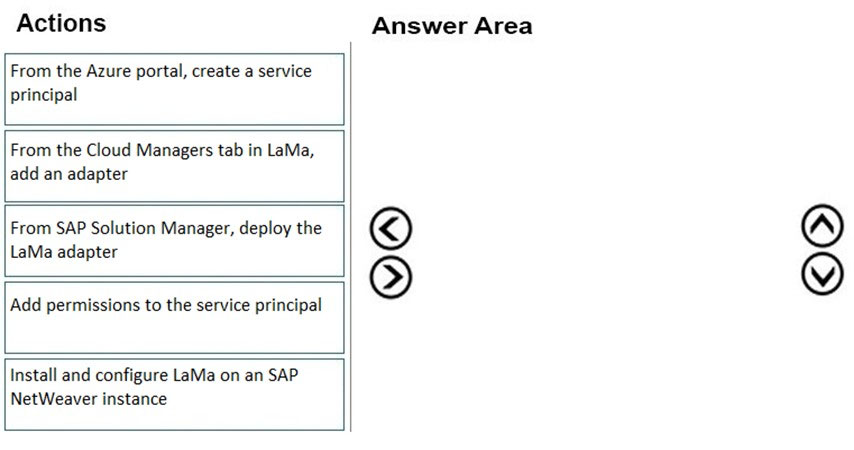
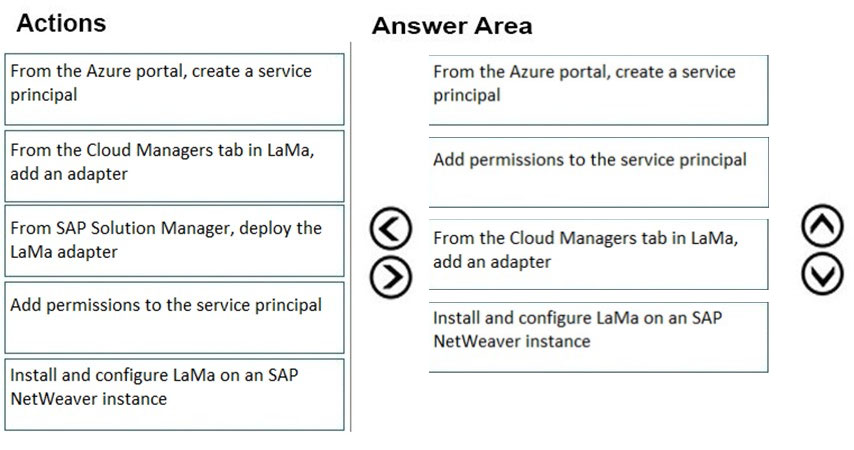
Step 1: From the Azure portal, create a service principal
The Azure connector can use a Service Principal to authorize against Microsoft Azure. Follow these steps to create a Service Principal for SAP Landscape
Management (LaMa).
Step 2: Add permissions to the service principal
The Service Principal does not have permissions to access your Azure resources by default. You need to give the Service Principal permissions to access them.
Step 3: From the Cloud Managers tab in LaMa, add an adapter
Create a new connector in SAP LaMa
Open the SAP LaMa website and navigate to Infrastructure. Go to tab Cloud Managers and click on Add. Select the Microsoft Azure Cloud Adapter
Step 4: Install and configure LaMA on an SAP NetWeater instance
Provision a new adaptive SAP system
You can manually deploy a new virtual machine or use one of the Azure templates in the quickstart repository. It contains templates for SAP NetWeaver ASCS,
SAP NetWeaver application servers, and the database. You can also use these templates to provision new hosts as part of a system copy/clone etc.
Note: To support customers on their journey into a cloud model (hybrid or entirely public cloud), SAP and Microsoft partnered to create an adapter that integrates the SAP management capabilities of LaMa with the IaaS advantages of Microsoft Azure.
References:
https://docs.microsoft.com/en-us/azure/virtual-machines/workloads/sap/lama-installation
HOTSPOT -
You have an Azure Availability Set that is configured as shown in the following exhibit.
Use the drop-down menus to select the answer choice that completes each statement based on the information presented in the graphic.
NOTE: Each correct selection is worth one point.
Hot Area: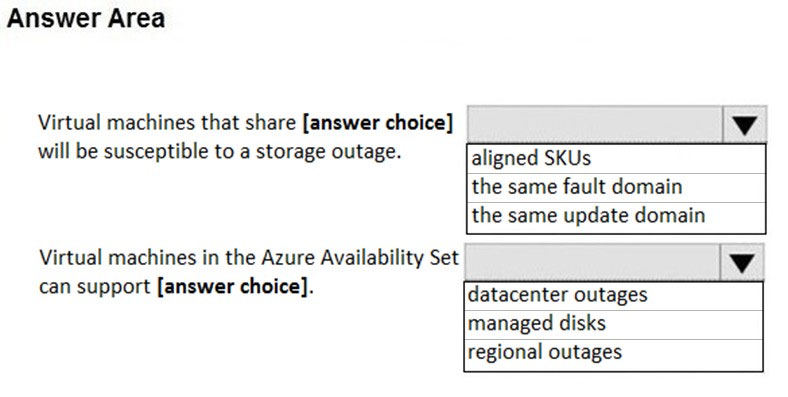
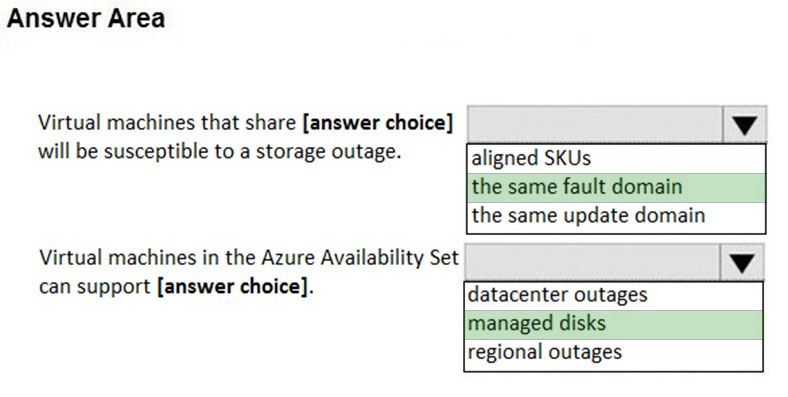
Box 1: the same fault domain -
Fault domains define the group of virtual machines that share a common power source and network switch. If a storage fault domain fails due to hardware or software failure, only the VM instance with disks on the storage fault domain fails.
Box 2: managed disks -
Managed disks provide better reliability for Availability Sets by ensuring that the disks of VMs in an Availability Set are sufficiently isolated from each other to avoid single points of failure. It does this by automatically placing the disks in different storage fault domains (storage clusters) and aligning them with the VM fault domain.
References:
https://docs.microsoft.com/en-us/azure/virtual-machines/windows/manage-availability
A customer that has a large enterprise SAP environment plans to migrate to Azure. The environment uses servers that run Windows Server 2016 and Microsoft
SQL Server.
The environment is critical and requires a comprehensive business continuity and disaster recovery (BCDR) strategy that minimizes the recovery point objective
(RPO) and the recovery time objective (RTO).
The customer wants a resilient environment that has a secondary site that is at least 250 kilometers away.
You need to recommend a solution for the customer.
Which two solutions should you recommend? Each correct answer presents part of the solution.
NOTE: Each correct selection is worth one point.
AC
A: An Azure Region Pair is a relationship between two Azure Regions within the same geographic region for disaster recovery purposes. If one of the regions were to experience a disaster or failure, then the services in that region will automatically failover to that regions secondary region in the pair.
C: For increased availability, you can deploy two VMs with two HANA instances within an Azure availability set that uses HANA system replication for availability.
References:
https://docs.microsoft.com/en-us/azure/virtual-machines/workloads/sap/sap-hana-availability-one-region
You plan to deploy an SAP environment on Azure that will use Azure Availability Zones.
Which load balancing solution supports the deployment?
B
When you deploy Azure VMs across Availability Zones and establish failover solutions within the same Azure region, some restrictions apply:
✑ You can't use an Azure Basic Load Balancer to create failover cluster solutions based on Windows Server Failover Clustering or Linux Pacemaker. Instead, you need to use the Azure Standard Load Balancer SKU.
References:
https://docs.microsoft.com/en-us/azure/virtual-machines/workloads/sap/sap-ha-availability-zones
You have an Azure subscription.
Your company has an SAP environment that runs on SUSE Linux Enterprise Server (SLES) servers and SAP HANA. The environment has a primary site and a disaster recovery site. Disaster recovery is based on SAP HANA system replication. The SAP ERP environment is 4 TB and has a projected growth of 5% per month.
The company has an uptime Service Level Agreement (SLA) of 99.99%, a maximum recovery time objective (RTO) of four hours, and a recovery point objective
(RPO) of 10 minutes.
You plan to migrate to Azure.
You need to design an SAP landscape for the company.
Which options meet the company's requirements?
A.
✑ Azure virtual machines and SLES for SAP application servers
✑ SAP HANA on Azure (Large Instances) that uses SAP HANA system replication for high availability and disaster recovery
B.
✑ ASCS/ERS and SLES clustering that uses the Pacemaker fence agent
✑ SAP application servers deployed to an Azure Availability Zone
✑ SAP HANA on Azure (Large Instances) that uses SAP HANA system replication for database high availability and disaster recovery
C.
✑ SAP application instances deployed to an Azure Availability Set
✑ SAP HANA on Azure (Large Instances) that uses SAP HANA system replication for database high availability and disaster recovery
D.
✑ ASCS/ERS and SLES clustering that uses the Azure fence agent
SAP application servers deployed to an Azure Availability Set
✑ SAP HANA on Azure (Large Instances) that uses SAP HANA system replication for database high availability and disaster recovery
B
With Availability Zones, Azure offers industry best 99.99% VM uptime SLA.
References:
https://docs.microsoft.com/en-us/azure/traffic-manager/traffic-manager-faqs
DRAG DROP -
Your on-premises network contains an Active Directory domain.
You have an SAP environment on Azure that runs on SUSE Linux Enterprise Server (SLES) servers.
You configure the SLES servers to use domain controllers as their NTP servers and their DNS servers.
You need to join the SLES servers to the Active Directory domain.
Which three actions should you perform in sequence? To answer, move the appropriate actions from the list of actions to the answer area and arrange them in the correct order.
Select and Place:
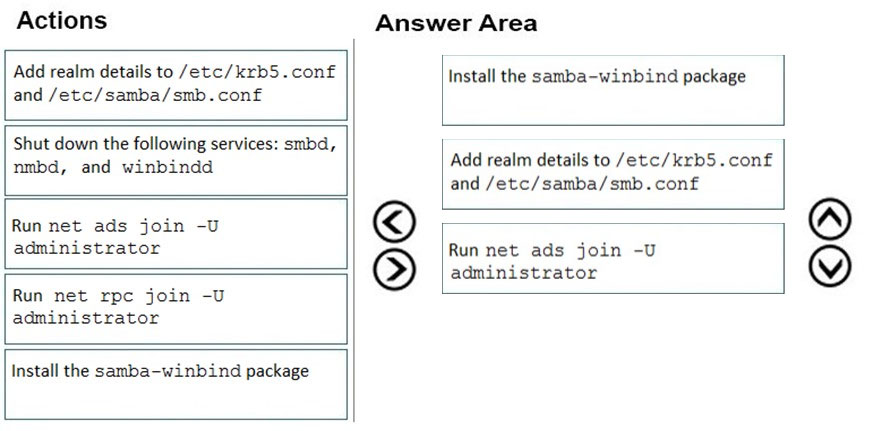
Step 1: Install the samba-winbind package
Install samba-winbind -
Step 2: Add realm details to /etc/krb5.conf and /etc/samba/smb.conf
Edit files - best way to do this is to use yast on test machine and copy files from it
In following examples you need to replace EXAMPLE/EXAMPLE.COM/.example.com with your values/settings
/etc/samba/smb.conf
[global]
workgroup = EXAMPLE
usershare allow guests = NO #disallow guests from sharing
idmap gid = 10000-20000
idmap uid = 10000-20000
kerberos method = secrets and keytab
realm = EXAMPLE.COM
security = ADS
template homedir = /home/%D/%U
template shell = /bin/bash
winbind offline logon = yes
winbind refresh tickets = yes
/etc/krb5.conf
[libdefaults]
default_realm = EXAMPLE.COM
clockskew = 300
[realms]
EXAMPLE.COM = {
kdc = PDC.EXAMPLE.COM
default_domain = EXAMPLE.COM
admin_server = PDC.EXAMPLE.COM
}
..
Step 3: Run net ads join -U administrator
Join the SLES 12 Server to the AD domain
References:
https://www.suse.com/support/kb/doc/?id=7018461
Note: This question is part of a series of questions that present the same scenario. Each question in the series contains a unique solution that might meet the stated goals. Some question sets might have more than one correct solution, while others might not have a correct solution.
After you answer a question in this section, you will NOT be able to return to it. As a result, these questions will not appear in the review screen.
You deploy SAP HANA on Azure (Large Instances).
You need to back up the SAP HANA database to Azure.
Solution: You configure DB13 to back up directly to a local disk.
Does this meet the goal?
B
You need to back up the SAP HANA database to Azure, not to a local disk.
References:
https://docs.microsoft.com/en-us/azure/backup/sap-hana-db-about https://docs.microsoft.com/en-us/azure/backup/backup-azure-sap-hana-database#configure-backup